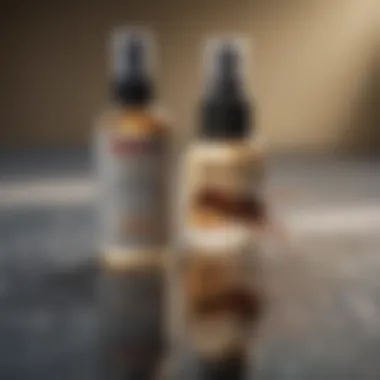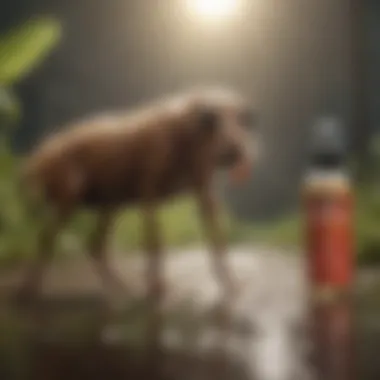Ultimate Guide to Using Adams Flea and Tick Spray


Intro
Pest control is an important concern for many homeowners. Among common pests, fleas and ticks are notable for their ability to affect both pets and living spaces. Managing these pests is essential to improve the comfort and safety of your home. To address this issue effectively, the use of products like Adams flea and tick spray can be beneficial. In this guide, we will explore the instructions and considerations for using this particular spray, while offering insights into pest identification, prevention strategies, treatment options, and safety measures.
Pest Identification
Identifying pests correctly is the first step in effective control. Fleas and ticks, often mistaken for other insects, have unique characteristics that set them apart.
Detailed descriptions of common pests
Fleas are small, wingless insects that are dark brown. They have flat bodies and can jump long distances. Adult fleas are about 1/8 inch long, making them difficult to spot.
Ticks are arachnids, not insects. They vary in size based on their life stage but are generally oval-shaped and can be brown or black. They do not jump, unlike fleas; they latch onto hosts when they brush against grass or shrubs.
Signs and symptoms of infestations
Homeowners should be vigilant for certain signs:
- Fleas: Frequent scratching by pets is a primary indicator. You may also notice flea dirt, which appears as small black specks on pet fur.
- Ticks: Most tick infestations are found on pets. You may see a tick embedded in the skin or notice unusual behavior like increased lethargy or biting at their skin.
Both pests can cause discomfort and health problems for pets and humans alike. Early detection is key in managing infestations effectively.
Prevention Strategies
Prevention is often more effective than treatment. Implementing proactive measures can significantly reduce the risk of flea and tick infestations in your home.
Home maintenance tips for pest prevention
- Keep your home and yard clean. Regularly vacuum carpets and upholstery, as well as wash pet bedding.
- Mow grass frequently and trim any shrubbery to reduce tick habitats.
- Seal any cracks and crevices in your home to prevent pest entry.
Natural deterrents and barriers
Using natural methods can also be effective:
- Essential oils, such as lavender or peppermint, act as natural repellents.
- Consider introducing beneficial insects like nematodes, which feed on flea larvae.
Establishing these barriers can create an environment less inviting to pests.
Treatment Options
When prevention methods fail, treatment becomes necessary. Here we discuss both chemical and natural options available.
Overview of chemical vs. natural treatments
Adams flea and tick spray is a chemical solution that targets both adult pests and their eggs. It is crucial to understand the benefits of such products:
- Quick elimination of pests
- Persistence against re-infestation
Natural treatments exist as alternatives, often with less immediate effects but may be suitable for those concerned about pet safety.
Step-by-step guides for DIY treatments
For those who prefer DIY approaches, consider the following steps:
- Prepare your environment: Remove pets and furniture from affected areas.
- Homemade flea spray: Combine apple cider vinegar, water, and a few drops of dish soap in a spray bottle. Apply to all surfaces.
- Regular treatment: Conduct treatments weekly until signs of pests are gone.
Remember, the key to successful pest control is consistency.
By documenting your efforts and results, you can adjust your approach based on what is effective in your specific environment.


Through understanding pest identification, implementing prevention strategies, and utilizing effective treatment options, you can take significant steps toward maintaining a pest-free home with the guidance of resources like Adams flea and tick spray.
Prelims to Flea and Tick Control
Flea and tick infestations pose significant threats to both pets and humans. Understanding the broad concept of pest management is crucial in creating a healthy living environment. This section emphasizes why managing fleas and ticks is not just a matter of comfort but also a necessity for maintaining household hygiene.
The Importance of Pest Management
Effective pest management is essential for many reasons. Firstly, flea and tick bites can lead to discomfort and allergic reactions in both pets and humans. Secondly, these pests can transmit various diseases; for example, fleas can carry pathogens that may cause infections in pets, while ticks are notorious carriers of Lyme disease. Control over these pests ensures a healthier life for your pets and family members.
Moreover, it is important to address the lifecycle of these pests. Fleas can reproduce rapidly, with a single female producing thousands of eggs within a short period. Similarly, ticks can go through multiple life stages, making timely management an ongoing challenge.
To summarize, a proactive approach to flea and tick control protects against potential health risks and reinforces peace of mind within the home.
Overview of Fleas and Ticks
Both fleas and ticks are small parasites that can cause a variety of problems if left unchecked. Fleas are wingless insects that rely on blood from mammals to survive. They have specialized mouthparts that allow them to pierce the skin and consume blood, which not only irritates the host but can also transmit diseases. Fleas thrive in warm environments and can easily invade homes, particularly through pets.
Ticks, on the other hand, are arachnids that latch onto the skin of their hosts. They can be more challenging to find due to their small size and penchant for hiding. Ticks can attach to animals and humans alike, and their bites can lead to severe health outcomes, including disease transmission.
Understanding the characteristics and behaviors of fleas and ticks is the first step in devising effective control strategies. By learning more about these pests, homeowners can tailor their pest management approaches to achieve better outcomes.
Understanding Adams Flea and Tick Spray
Understanding Adams Flea and Tick Spray is essential for homeowners aiming to control pest infestations efficiently. This spray offers a viable solution against the relentless problem of fleas and ticks, which can negatively impact both pets and living environments. By comprehending its components and effectiveness, users can make informed decisions, ensuring they protect their homes and pets effectively.
Product Composition and Ingredients
Adams Flea and Tick Spray is formulated with a blend of active ingredients that are designed to target fleas, ticks, and other pests. Notably, it contains S-methoprene, an insect growth regulator, which disrupts the life cycle of fleas by preventing them from developing into adulthood. Another key ingredient, Pyrethrins, is derived from chrysanthemum flowers and provides an instant knock-down effect on adult insects. These ingredients work synergistically to offer both immediate and long-lasting protection.
It is important to read the label for specific ingredient information and safety instructions. Knowing what is in the product helps homeowners assess its suitability for their specific needs and reduces the risk of adverse reactions.
Efficacy of the Spray
The efficacy of Adams Flea and Tick Spray can be assessed based on user experience and scientific studies. Many users report significant reductions in flea and tick populations after applying the spray as directed. The formulation is particularly effective when applied to pets and treated surfaces, effectively eliminating pests on contact.
The duration of protection it provides may vary. Typically, the results can last for several weeks, dependent on environmental factors and the level of infestation. For best results, repeated applications may be necessary, especially in highly infested areas. Regular monitoring post-application is critical to assess the long-term efficacy of the treatment.
Effective pest management is not just about application; it is about understanding how products work.
In summary, understanding the elements that contribute to the effectiveness of Adams Flea and Tick Spray is paramount for households facing pest challenges. By familiarizing themselves with the product's composition and its efficacy, homeowners can implement a proactive approach to pest control.
Preparation for Application
Preparation is a critical phase when applying Adams Flea and Tick Spray. It involves gathering the right supplies and clearly understanding the areas that need treatment. Proper preparation sets the foundation for effective pest control, ensuring that the spray works its best and that you minimize any potential side effects.
When preparing for the application, consider these elements:
- Safety: Ensuring safety for yourself, your pets, and anyone else in the home is vital. Properly preparing can avoid unwanted exposure to chemicals.
- Effectiveness: Understanding the areas where fleas and ticks thrive allows for targeted application, making the treatment more effective.
- Efficiency: A well-prepared environment facilitates a smoother application process, saving time and reducing hassles.
Gathering Necessary Supplies
To apply Adams Flea and Tick Spray effectively, specific supplies are needed. Here’s a checklist of items to gather before starting:
- Adams Flea and Tick Spray: The main product for treatment.
- Protective Gear: Gloves and a mask to protect skin and respiratory health during application.
- Measuring Container: If needed, for measuring the amount of spray.
- Cleaning Supplies: In case of any spills, have paper towels or cloths ready.
- Vacuum Cleaner: For pre-treatment cleaning and post-treatment follow-up.
- Trash Bags: For disposing of contaminated items.
Having these supplies on hand reduces risks and increases the likelihood of efficiently eradicating pests.
Identifying Infested Areas


Recognizing where fleas and ticks are located within your living spaces is crucial. It allows for strategic application and maximizes the effectiveness of the treatment. Here are some suggestions for identifying infested areas:
- Check Pets: Inspect your pets closely. Fleas are often found in their fur, and ticks can attach to their skin.
- Examine Living Spaces: Look in areas where pets usually spend time, such as beds, carpets, and furniture.
- Signs of Infestation: Small black specks (flea feces), flea eggs, or live fleas can indicate an issue. Ticks may be found on pets or near areas where pets roam.
"Effective pest control begins with understanding where to focus your efforts."
By thoroughly identifying infested areas, you can apply Adams Flea and Tick Spray more strategically, ensuring you invest your time and efforts effectively. This makes the process not just a necessity, but rather a precise strategy for a flea and tick-free environment.
Application Directions
The Application Directions section is critical to ensuring the effective use of Adams Flea and Tick Spray. This segment provides clear, step-by-step instructions that can greatly improve the success of pest control efforts. Misapplication can lead to insufficient results, so understanding the right method is essential for homeowners. A precise application strategy maximizes the product's effectiveness while minimizing any potential hazards to pets and humans in the environment.
Step-by-Step Application Process
When using Adams Flea and Tick Spray, follow these key steps to achieve optimal results:
- Preparation: Before starting the application, ensure the area is free of pets and children. This step prevents accidental exposure to the spray, ensuring safety.
- Shake the Can: It is crucial to thoroughly shake the bottle of Adams spray before use. Doing so ensures that the ingredients mix properly, which enhances effectiveness.
- Check the Nozzle: Make sure the nozzle is set to the correct setting for spray application. Usually, the nozzle should be pointed away from you when beginning to spray.
- Spray the Affected Areas: Hold the spray can about 12 inches from the surface and apply a light, even coating. Target areas where fleas and ticks are likely to inhabit, such as carpets, upholstery, and cracks in the floor.
- Allow to Dry: After applying the spray, leave the area undisturbed for at least an hour. This time allows the product to penetrate surfaces effectively.
Following these steps will enhance the effectiveness of the Adams Flea and Tick Spray, addressing infestations efficiently.
Specific Instructions for Pets
Applying Adams Flea and Tick Spray to pets requires careful attention. Pets can be sensitive to sprays, so specific guidelines must be followed:
- Avoid Spraying Directly on Pets: Do not apply the spray directly onto your pets' fur. Instead, treat the surrounding environment where pets frequently spend their time.
- Use a Harness: If necessary, use a harness or hold pets to restrict their movement during application. This control ensures that they are kept away from sprayed areas until it has dried.
- Monitor Reactions: After application, observe your pets for any adverse reactions. If any signs of discomfort arise, contact a veterinarian immediately.
- Regular Bathing: Maintain a regular bathing schedule for pets using suitable shampoos. This practice can help mitigate any residual effects of sprays used in the environment.
Application in Home Environments
Creating an effective application plan within home environments can further enhance pest control efforts:
- Target High-Risk Areas: Focus on areas that are prone to flea and tick infestations such as carpets, bedding, and furniture. Proper targeting is key.
- Duration of Vacating: It is recommended to vacate the treated spaces for at least one hour after application, allowing time for the spray to become effective.
- Ventilation: Ensure adequate ventilation in the treated area. Open windows if possible to reduce lingering spray fumes, keeping the environment safe and comfortable.
- Routine Cleaning: To maintain a flea-free home, incorporate routine vacuuming and cleaning practices. Regular cleaning can help remove eggs, larvae, and adult fleas and ticks.
"Employing the right methods in applying flea and tick sprays can significantly impact the effectiveness of pest control measures in your home."
By following these directions closely, you can utilize Adams Flea and Tick Spray more effectively, safeguarding your home and pets from infestations.
Safety and Precautions
Ensuring the safety of both humans and pets during the application of Adams flea and tick spray is paramount. Neglecting safety measures can lead to unforeseen complications, including allergic reactions or harmful exposure. This section outlines crucial safety precautions to follow when using the spray.
Identifying Sensitive Areas
Identifying sensitive areas in your home is essential to ensure safe application. Sensitive areas include locations where children play, pets frequent, and spaces that are heavily used. Here are key points to consider:
- Children’s Play Areas: Always avoid spraying in gardens or rooms used for children's play. Their skin is more susceptible to reactions from chemicals.
- Pet-Specific Zones: Ensure that areas where pets rest or roam are considered. Pets may have allergies or sensitivities to certain ingredients.
- Ventilation: Check areas where airflow is limited. Closed spaces can trap chemicals, increasing the risk of exposure.
- Furniture and Fabrics: Note which surfaces and fabrics could absorb the product. Some materials may react with the spray, leading to damage.
By being aware of these sensitive areas, you can apply the spray more effectively while minimizing risks.
Post-Application Precautions
Once the application is complete, specific precautions must be taken to ensure the safety of your home and the health of your family and pets.
- Keep Pets and Children Away: After applying the spray, it's important to keep pets and children out of treated areas until they are fully dry. This reduces the risk of accidental ingestion or skin contact.
- Follow Drying Times: Adhere to the product instructions regarding drying times. Each product may have different recommendations, and it’s crucial to respect these to maximize effectiveness and safety.
- Clean Up Appropriately: After the treatment has dried, vacuum the treated areas to pick up any remnants. This is especially important in areas with heavy foot traffic. Disposing of the vacuum bag afterward can also help reduce any residual chemical exposure.
"Taking precautions at every stage of application is the key to safe pest control."
- Monitor for Reactions: After applying the spray, observe pets for any unusual behavior or allergic reactions. In case of any signs of distress, consult a veterinarian promptly.
Implementing these post-application precautions will ensure a safe environment for all household members while maintaining effective pest control.


Monitoring and Maintenance
Monitoring and maintenance are critical components when using Adams Flea and Tick Spray. Applying the spray doesn't guarantee an immediate end to the problem without continued vigilance. Regular checks help ensure that the treatment remains effective over time.
Evaluating Treatment Effectiveness
After application, it is essential to assess how well the product is working. Look for signs of flea and tick activity. You might notice reduced scratching in pets or fewer pests in the household. A good method to evaluate is to perform weekly checks on your pet's fur and inspect common areas in the home, like carpets and bedding. Keep track of any new bites or signs of irritation, as these can indicate ongoing infestations.
Steps to Take if Infestation Persists
If you find that fleas or ticks remain an issue, there are a few effective steps. First, consider reapplying the Adams Flea and Tick Spray according to the directions. Make sure you follow the recommended intervals closely. Clean your living space thoroughly, including vacuuming carpets and washing bedding. If the infestation continues, you might need to consult a pest control professional for additional services or consider using other products in conjunction with the spray for more impact.
Scheduling Regular Preventive Treatments
To ensure long-term protection against fleas and ticks, schedule preventive treatments. Adams Flea and Tick Spray should be part of a holistic pest management strategy. Look for a seasonal schedule; many homeowners choose to treat their homes every few months or during peak flea and tick season. Regular treatments can help break the life cycle of pests. It is also wise to maintain a clean environment, as consistent cleaning reduces the risk of reinfestation.
Consistency is key in pest management. Skipping treatments can lead to new infestations, making previous efforts less effective.
Implementing these monitoring and maintenance practices enhances the effectiveness of Adams Flea and Tick Spray and ensures a pest-free living environment.
The End
The conclusion of this guide serves as a critical reflection on the overall effectiveness and importance of utilizing Adams Flea and Tick Spray as a reliable pest control solution. Pest management is not merely a task to be performed, but rather a crucial component of maintaining a healthy living environment, particularly for pet owners. The article has established steps for understanding the spray's efficacy, preparation, application, and follow-up actions to ensure lasting results.
Summary of Key Points
- Preparation: Gathering necessary supplies and identifying infested areas are essential first steps.
- Application Directions: Following meticulous application processes guarantees safer and more effective treatment.
- Safety Precautions: Understanding sensitive areas in your home and adhering to post-application safety measures protects both pets and residents.
- Monitoring & Maintenance: Evaluating treatment effectiveness and regular prevention schedules foster long-term control over flea and tick infestations.
These elements collectively enhance the overall effectiveness of pest control practices.
Final Thoughts on Flea and Tick Management
Effective flea and tick management is fundamentally about responsibility. As a homeowner or pet owner, the onus is on you to ensure your environment is free from these pests. Every action, from preparation to post-application assessment, contributes to better overall health for your pets and your family. By adopting a structured approach, particularly with products like Adams Flea and Tick Spray, you create a barrier against pest re-infestation. This organized method maximizes the benefits derived from pest control measures, ensuring you enjoy a comfortable living space devoid of unwanted intruders.
"Consistent management and preventive measures turn pest control into a successful strategy."
By synthesizing the illustrated steps, homeowners can foster a proactive attitude towards pest management. This guide aims not only to educate but also to empower readers to make informed decisions that positively impact their living spaces.
References and Further Reading
In any comprehensive guide, especially one relating to pest control like Adams flea and tick spray directions, the inclusion of references and further reading cannot be overlooked. This section serves to provide readers with a deeper understanding of the topics discussed. Whether it’s the effectiveness of the product, proper usage, safety measures, or maintenance strategies, having access to verified studies and expert opinions enhances credibility. Moreover, it empowers readers to make informed decisions regarding pest management in their homes. The insights derived from such literature can lead to improved practices and better outcomes.
Citations for Product Studies
Citations from scientific studies are essential in validating the claims about any pest control product. For instance, studies published in peer-reviewed journals often provide concrete data on the efficacy of certain ingredients found in Adams flea and tick spray. This information can help consumers understand how these components act against fleas and ticks.
Specifically, research findings can reveal how long the product remains effective and under what conditions it performs best. Readers may find it beneficial to review studies documenting the success rates of flea and tick treatments to compare various products.
- Example citations:
- A 2020 study in the Journal of Entomology examined the effectiveness of various topical treatments.
- Research published in Pest Control Technology reveals the impact of different insecticides on flea and tick populations in household settings.
Recommended Literature on Pest Control
Literature related to pest control offers a wealth of knowledge. Various sources provide advice and strategies that can work hand-in-hand with the use of Adams flea and tick spray. This includes understanding the lifecycle of fleas and ticks, behavioral patterns of these pests, and the best practices for prevention.
Here are some recommended readings to consider:
- "The Flea: A History of the World’s Most Infamous Parasite" by Katherine E. Williams
This book dives into the biological aspects and historical significance of fleas. Understanding their biology can assist in better pest control methods. - "Tick Management Handbook" published by the Centers for Disease Control and Prevention (CDC)
This comprehensive guide details tick management techniques and preventive actions.
"Knowledge is the first line of defense against pests. Understanding these insects helps us stay ahead of infestations."
- "Home Pest Control: The Comprehensive Guide to Protecting Your Home" by Charles Robinson
This book provides insights on integrated pest management approaches that go beyond just using sprays.
Having these resources at hand can significantly enrich one's pest management strategy and enhance the overall effectiveness of products like Adams flea and tick spray.



